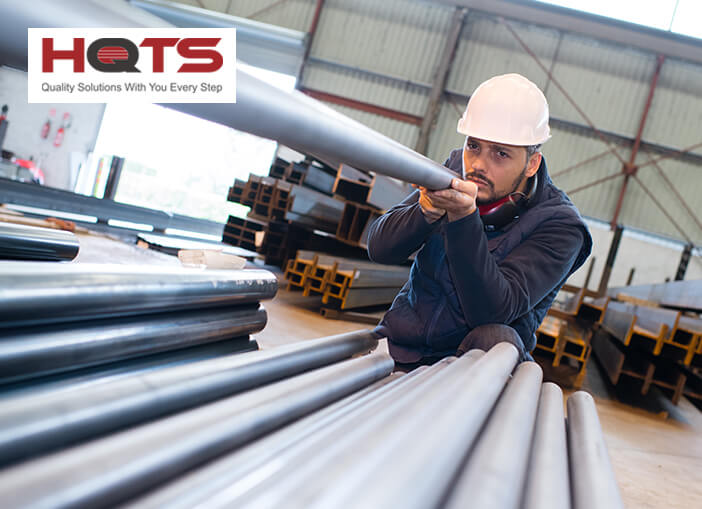We use steel in many products, anywhere from household products like refrigerators and televisions to cutlery and industrial machinery. However, steel production is not always going to be perfect, it’s just like any other material – there are going to be faults that might arise during the production. Therefore, quality control is important.
In this guide, we´ll help you assess the steel quality and give you tips on how to conduct quality control of steel.
What Are the Different Types Of Steel?
Steel is manufactured primarily from iron with the addition of carbon and a number of other elements. But it is not a single product. In fact, the World Steel Association claims there are more than 3.500 different grades of steel. Now, these different grades of steel can be labelled into four main types. Each type of steel has its own properties that will make it better suited for a certain purpose.
The 4 Main Types of Steel
1. Carbon Steel
Carbon Steel contains only 2% carbon or less by weight, and is a strong and durable material. It is often used in construction or industrial projects because it has high tensile strength. Other common products are kitchen knives, springs, bolts.
2. Stainless Steel
Stainless steel is composed of iron and chromium and other materials, which makes it very durable and resistant to weather conditions. Stainless steel is often used on surgical tools, utensils and appliances because it does not stain or discolour the surface.
3. Alloy Steel
Alloy steel is a type of steel that contains a combination of different elements, such as vanadium, chromium and nickel, to name a few. Alloy steel is stronger than regular steel because these alloying elements increase the machinability and corrosion resistance of the material. It is commonly used to manufacture pipes, and heating elements in appliances like pots and pans and toasters.
4. Tool Steel
Tool steel is often made from around 75% scrap and has a carbon content between 0.5% and 1.5%. It is typically hardened by heat treatment to increase its heat-resistance, toughness, and strength. As its name implies, it is used for manufacturing machinery.
What is Steel Quality?
Quality of steel is often defined in terms of how the material meets its specifications and chemistry, and can also be described by its cleanliness of it or how homogeneous it is.
Why Quality Control of Steel is Important
Quality steel is a must to avoid steel structure fatigue or failure. Problems that can arise during manufacturing could result in weakness, particularly when the surface is folded or moulded.
Steel quality inspections are an integral part of the quality control of steel. Its purpose is to check that the requirements of the specification are being complied with. Checking the processes, procedures and materials required for the manufacturing of steel structures is vital as durability can be significantly reduced if not fully complied with.
Because of the complexity of steel production, it is always a good idea to use third-party steel quality inspection services to inspect the quality of material. All issues that arise from the inspection must be rectified immediately, as otherwise it can reduce the expected timescale to when the first maintenance of the material will be needed. To specify the various physical and mechanical properties of the finished product, various tests, both destructive and non-destructive, need to be performed.
How To Check Steel Quality in the Steel Industry?
A range of methods exists to test the strength and durability of steel. No matter if you want to check stainless steel quality, or tool steel quality. We´ve summarised a series of quality control tests for the steel industry that can be carried out on steel below.
Metallurgical Testing for Steel
Metallurgical testing in steel quality checklist is the process of testing the steel by subjecting the material to mechanical, thermal, or chemical actions in order to evaluate its properties. The goal of metallurgical testing is to gain knowledge about the steel´s composition and structure to predict its behaviour under various conditions. A section of the sample is firstly polished and then examined and different characteristics are produced through mixing the steel with other substances and later analysed under a microscope.
Hardness Value Testing for Steel
Hardness tests are a common method used in steel quality control to evaluate the hardness of steel. The hardness value test helps to compare between the materials or treatments. These tests are usually performed by impressing a test specimen, which is resting on a rigid platform under a static load.
Test the Hardenability on Steel
The hardenability test determines the depth and distribution of hardness induced by quenching. Also known as the Jominy Test. A long sample of the steel is heated uniformly to the correct temperature before the sample is removed from the furnace and placed on a fixture where water contacts the bottom face of the sample. After 10 minutes, the sample is removed and the results should show a curve of hardness versus the distance from the quenched end.
Tension Test on Steel
Test for tension is a method used to measure the amount of tension, yield strength, and ductility in the steel. A tension test runs at a constant load and temperature. The strength of the material is tested to ensure its ability to withstand external forces without breaking. By pulling on something, you can quickly determine how the material will react to forces being applied in tension.
Ductility Testing on Steel
The ductility of a material is indicated by the amount of deformation that’s possible until it breaks. The strength, elasticity and toughness of steel are determined by the amount and rate that it can deform under tensile stress.
Compression Test on Steel
Compression tests are performed on small cylinders, blocks or strips to determine the ability of the material and whether it can undergo large plastic deformations and its limits. Samples are placed between pressure plates and compressed.
Fatigue Test on Steel
The fatigue test is used to determine the behaviour of the materials when subjected to reparations of fluctuating loads. It is used to simulate stress conditions that’ll be developed in materials under normal service conditions. The fatigue limit is shown by counting the number of stress cycles applied in one direction and then another, until the steel breaks.
Impact Testing of Steel
Impact tests are used to indicate the behavior of the steel when subjected to high rates of loading, usually bending, tension or torsion. A swinging pendulum of a fixed weight raised to a standard height is used to strike the sample and the weight of the pendulum times the difference in heights helps to indicate the amount of energy absorbed by the specimen.
Wear Resistance Test on Steel
Wear resistance is a complex test and usually applied to specific equipment designed to simulate actual service conditions. Various types of environmental testing are carried out to witness how the material reacts to actual conditions.
Corrosion Test on Steel
Corrosion tests involve the destruction of a material by chemical, electrochemical or metallurgical interaction between the environment and material. Various types of environmental exposure tastings are done to simulate actual use conditions.
Creep Test on Steel
Creep tests are used to determine the continuing change in the deformation of the steel at elevated temperatures when stressed below the yield strength. A creep test is a tension test run at a constant load and temperature.
Test the Machinability on Steel
Machinability is the ease with which the steel may be machined and many factors are considered in arriving at machinability ratings which are expressed as a percentage in compassion with AISI 1112 steel, which is rated at 100%.
Test the Radiography on Steel
Radiography of steel materials involves the use of x-rays and the short-wavelength electromagnetic rays that are capable of passing through large thicknesses of metal and are typically used to test casting and welded joints for shrinkage voids.
Magnetic Particle Testing on Steel
Magnetic particle inspection is an effective method of detecting cracks, tears, seams, and inclusions in steel and iron. This method will detect any discontinuities just below the surface that are hard to spot with the naked eye.
Ultrasonic Testing on Steel
Ultrasonic testing utilizes sound waves above the audible range and this non-destructive test employs electronically produced high-frequency sound waves to penetrate metals and other materials. It is used to detect and locate such defects as shrinkage voids, internal cracks, porosity and large non-metallic inclusions.
Eddy Inspection on Steel
Eddy inspection is used to inspect electrically conducting materials for defects and variations in composition. Eddy testing involves placing a varying magnetic field near an electrically conducting sample. Properties such as hardness, alloy composition, chemical purity and heat treat conditions can influence the magnetic field and may be measured through the use of eddy current tests.
Conclusion: Steel Quality Control: What are the Types of Quality Inspections?
Steel comes in many different grades, and there are a series of methods to inspect the steel quality. If you need help to assess the quality of your steel material, contact us at AQM BD. We can conduct quality control tests in the steel industry for many different products including; bars, chains, containers, ingots, metallic plates, sheets, strips and coils, nets, fences, section bars, tubes and wires, and help you with inspection services such as PSI inspection services .Thanks to our global reach, we can serve our clients worldwide and in a timely manner.






